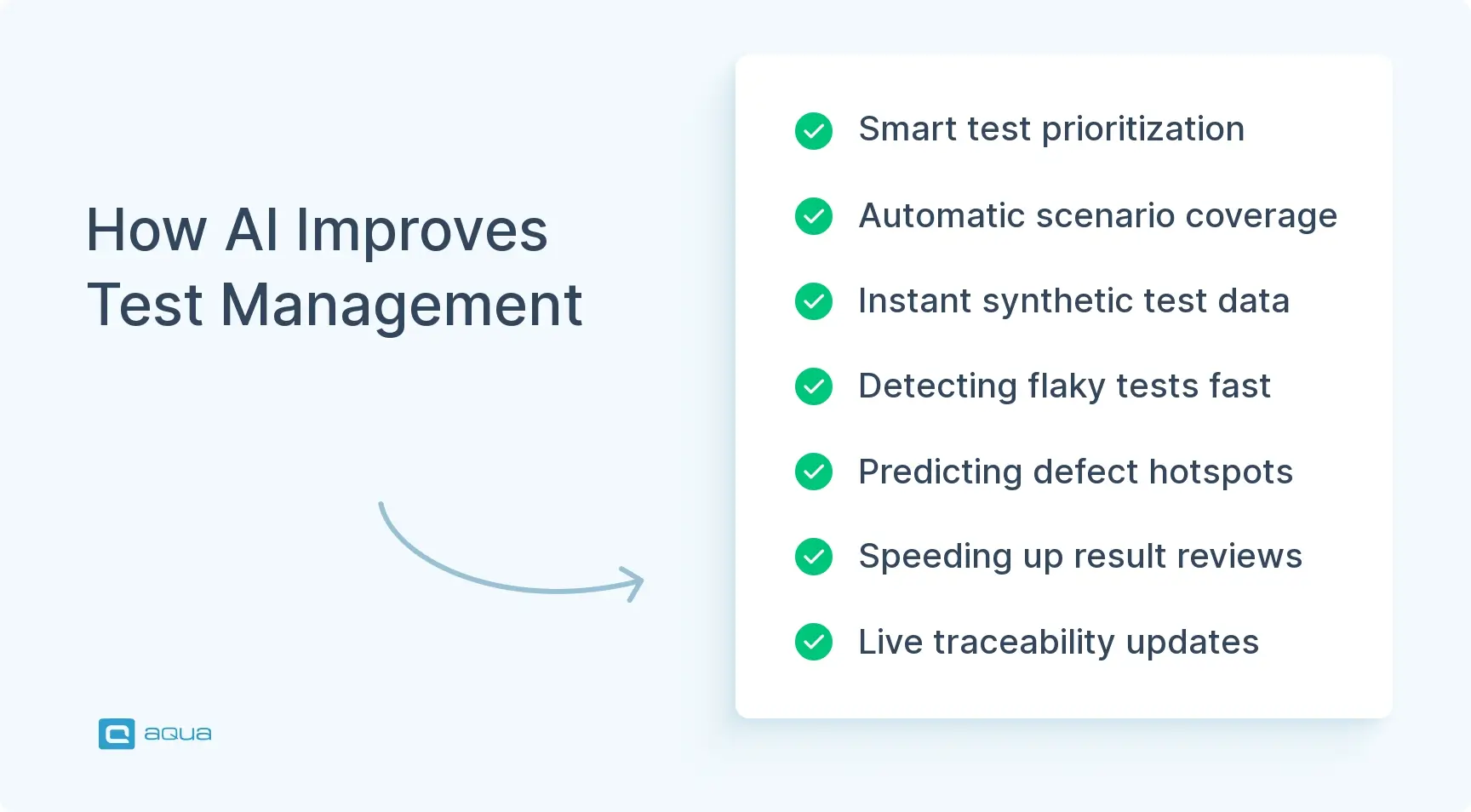Key Takeaways
- Modern test management faces nine critical challenges, including test case prioritization, incomplete coverage, and managing test environments across increasingly complex software systems.
- AI-powered solutions are transforming test management by analyzing code changes and historical defect patterns, with Facebook’s Sapienz platform reportedly reducing crash rates by over 50%.
- Flaky tests that pass and fail inconsistently create serious bottlenecks in testing pipelines, wasting investigation time and eroding confidence in the entire test suite.
- Cloud-based testing platforms use machine learning to dynamically allocate resources based on usage patterns, reducing environment setup time by up to 70%.
- AI-powered analytics can reduce time spent investigating test results by up to 80%, allowing teams to focus on fixing issues rather than diagnosing them.
Software testing teams are drowning in flaky tests, environment issues, and mountains of results data; while facing tighter deadlines than ever. See how AI-powered solutions are helping QA teams overcome these challenges and deliver higher quality software faster 👇
Understanding Test Management Challenges
Test management means planning, running, and tracking all testing activities to ensure software works before it ships. Simple in theory, messy in practice.
The problems QA teams face compound quickly. You need thorough test coverage, but have tight deadlines. Test environments should mirror production, but rarely do. Test results pile up faster than anyone can analyze them. Resources stay flat while testing complexity grows. These issues don’t wait politely in line, they hit simultaneously and make each other worse.
We will break down the main challenges below, but for now, you have to know this: they show up everywhere because they stem from fundamental tensions between thoroughness and speed, between ideal conditions and available resources. Understanding how each challenge manifests helps you address them systematically instead of firefighting constantly.
1. Difficulty in Test Case Prioritization
When you have hundreds or thousands of test cases and limited time, deciding which tests to run first becomes critical. Test case management challenges increase as release cycles compress and pressure increases to ship faster.
Effective prioritization requires understanding which features carry the highest risk, which areas changed recently, and which tests historically catch the most critical defects. Without this insight, teams default to gut feelings or run whatever’s fastest to execute. Both approaches leave critical bugs undiscovered until production.
Poor prioritization shows up in two ways. High-risk issues slip through when important tests get pushed to the end and time runs out. Or teams waste time on low-risk areas while critical functionality stays inadequately tested.
Test management solutions like aqua cloud help you prioritize smarter by linking test cases directly to requirements. This traceability shows which tests validate critical business functionality versus nice-to-have features. When you know a test case validates a high-priority requirement, that test moves up the priority list automatically. The platform’s complete visibility into requirement coverage means you can identify gaps where critical features lack sufficient testing and focus effort where it actually matters for quality.
2. Incomplete Test Coverage
Manually testing everything is impossible. You can test your main features, but what about all the different ways users might interact with them? What about the edge cases? The scenarios you didn’t think of? There’s just too much ground to cover.
Coverage gaps happen for predictable reasons. Maybe the requirements weren’t clear from the start. Maybe you overlooked certain edge cases. Maybe you can’t see how different parts of the system connect. Or maybe your application is just too large and complex to test everything manually.
When bugs slip through these gaps and reach your users, the consequences are real. Fixing a production bug costs way more than catching it during testing. Your customers get frustrated. Your brand takes a hit. And your team is left wondering what else you might have missed.
The good news is, you don’t have to write every test case yourself anymore. Modern tools can analyze your requirements, look at how your application actually works, and generate test cases automatically. They catch scenarios you wouldn’t have thought to test and build coverage that would otherwise take your team months. A prime example of this: aqua cloud.
Aqua cloud offers a purpose-built solution designed specifically to address the prioritization and test coverage gaps that plague QA teams today. Its AI-powered test case generation capabilities can create comprehensive test scenarios from requirements in seconds, ensuring no critical edge cases are overlooked. With aqua’s intelligent prioritization features, your team can focus testing efforts where they’ll have the most impact, using risk-based analytics to identify high-risk areas before they become production problems. The centralized test repository eliminates fragmentation and ensures complete traceability from requirements to execution, while customizable dashboards provide instant visibility into coverage gaps and testing progress. Jira, Azure DevOps, Confluence, and automation integrations like Selenium, Jenkins, Ranorex, help you supercharge your efforts within your toolkit. Can you afford to let these common test management challenges compromise your software quality?
Overcome test management challenges with 97% less effort using aqua's AI-powered platform
3. Availability of Effective Test Data
You can’t test properly without good data. And by good, we mean realistic, diverse data that actually represents what happens in the real world. But getting that data? That’s where things get complicated.
Lets say you’ve got three bad options. You could use production data, but that’s a privacy nightmare and probably violates a dozen regulations. You could manually create test data, but that takes forever and you’ll never cover everything. Or you could try maintaining test datasets across multiple environments, which is its own special kind of headache.
Without the right test data, you’re flying blind. You can’t properly validate business rules. You can’t explore edge cases. You can’t test performance under realistic conditions. You’re basically hoping for the best.
Take a financial application with complex calculation logic as an example. You need data for:
- Different account types and balance scenarios
- Various transaction patterns and frequencies
- Edge cases like overdrafts, refunds, and corrections
- High-volume loads that mirror peak usage
Miss any of these, and critical bugs slip through. This gets even trickier if you’re testing AI features, which need diverse, representative datasets to work properly across all scenarios.
So whats the solution? The answer: tools that generate synthetic test data for you. Aqua clouds AI Copilot does it in seconds. It analyses your existing data to understand the patterns and relationships, then create realistic test data at whatever scale you need. No privacy issues. No manual work. No waiting around.
4. Flaky Test Cases
Flaky tests are the worst. They pass one minute, fail the next, and nothing in your code has changed. They create confusion, waste hours of investigation time, and make your entire test suite feel unreliable.
But the real damage goes deeper. When your team can’t trust test results, they start ignoring failures. “Oh, that’s probably just flaky” becomes the default response. And that’s dangerous because eventually, a real bug gets dismissed as flakiness and makes it to production.
Flaky tests also wreck your CI/CD pipeline. Intermittent failures mean delayed releases and unpredictable delivery schedules. Your deployment process becomes a gamble instead of a reliable system.
So what causes flakiness? Usually one of these culprits:
- Timing issues where tests expect responses faster than the system can deliver
- Environmental differences between test runs
- External dependencies that behave inconsistently
- Poorly written test code with hidden state or race conditions
Modern testing tools can spot flaky tests by analyzing execution logs and identifying patterns of inconsistency. They assign flakiness scores so you know which tests to fix first. Some can even fix common issues automatically, like adjusting timing parameters or implementing better waiting mechanisms.
The goal is simple: make your test suite trustworthy again so your team can actually rely on what it’s telling them.
5. Unidentified Defects Passing to Final Product
No matter how thorough your testing is, some bugs will slip through. It happens. But when defects reach production, they become exponentially more expensive and damaging. We’re talking upset users, damaged reputation, and a scramble to fix issues under pressure.
Why do bugs escape? The usual suspects:
- Test coverage that misses critical scenarios
- Test environments that don’t match production reality
- Edge cases nobody thought to test
- Software that’s simply too complex to test every possible path
Here’s what makes this frustrating: the bugs that escape are often weirdly specific. A banking app that only fails processing certain transaction types under heavy load. An e-commerce checkout that breaks only for users with special characters in their addresses. These aren’t scenarios you’d typically think to test, but they can affect thousands of users.
The traditional approach is reactive. Find the bug in production, fix it fast, hope it doesn’t happen again. But what if you could predict where bugs are likely to hide before they even appear?
That’s what modern defect prediction does. By analyzing code changes, commit patterns, and historical bug data, these tools can flag risky areas before testing begins. Your team knows exactly where to focus their efforts and which changes need extra scrutiny.
The results speak for themselves. Teams using defect prediction reduce escaped defects by 40% or more, not by testing more, but by testing smarter. They focus resources where the risk is highest and catch problems before users ever see them.
The biggest challenge for me has been when developers (incl CTO) think they know more about testing than the alleged testing expert on the team. Resistance to change is always more important than improvements which will elevate quality.
6. Managing Diverse Test Environments
Your application needs to work everywhere. Different operating systems, browsers, devices, cloud configurations. The matrix is massive, and testing across all of it? That’s one of the biggest test management challenges teams face today.
Here’s where environment management falls apart:
- Waiting for environments to become available
- Test environments that don’t match production settings
- Configuration drift that happens over time
- The sheer cost of maintaining multiple parallel environments
When environment issues hit, testing schedules slip. Teams start taking shortcuts. Quality suffers.
And it might get worse. Microservices applications have dozens of interconnected components, each needing its own configuration. Mobile apps need testing across countless device types, OS versions, and network conditions. Web apps face an endless browser compatibility matrix.
The old way was manual provisioning and hoping everything stayed consistent. Then what about the new way? Automated environment management that provisions what you need, when you need it.
Modern platforms use predictive analytics to understand your testing patterns. They spin up environments on demand based on what you’re actually testing. They catch configuration drift before it causes problems. They optimize resource allocation so you’re not burning money on idle environments.
The result: environment setup that used to take hours now takes minutes. Consistency across test runs. Resources available when your team needs them, without the waste. That’s not just faster testing. That’s testing you can trust.
7. Efficient Test Result Analysis
Your test automation generates mountains of data. Logs, screenshots, performance metrics, test reports. It all piles up fast, and somewhere in that pile are the insights you actually need. The question is, will you be able to find them all?
This is a massive time sink and one of the core challenges in test management. Your team spends hours manually reviewing results, digging through logs, trying to figure out what actually matters. Meanwhile, subtle patterns that signal bigger problems get lost in the noise. The data is there, but you can’t see it.
Here’s what effective test result analysis actually requires:
- Understanding failure patterns, not just pass/fail status
- Recognizing trends across multiple test runs
- Correlating results with specific code changes
- Generating actionable insights that lead to actual fixes
Manual analysis can’t keep up. There’s too much data and too little time.
Modern analytics platforms change this completely. They automatically summarize test logs and highlight the most probable root causes of failures. They detect patterns across test runs to spot unstable components before they cause critical failures. They connect dots that humans would miss.
Instead of spending days figuring out what went wrong, you spend hours actually fixing it. More importantly, these tools catch things human analysts miss, like correlations between seemingly unrelated failures or early warning signs of performance issues.
The goal is a better analysis that actually helps you improve quality over time.
8. Maintaining Test Documentation and Traceability
Test documentation matters. You need clear traceability between requirements, test cases, and defects. But in reality, documentation often becomes an afterthought when deadlines loom.
A typical scenario: your software evolves constantly. Features change. Requirements shift. Code gets refactored. And your test documentation? It falls further and further behind. Manual updates take too long, so they get postponed. Then postponed again. Eventually, nobody trusts the documentation anymore.
This creates real problems. Knowledge gets trapped with individual team members. New testers struggle to onboard because the documentation doesn’t match reality. Audit compliance becomes a nightmare. And when you need to understand which tests cover which requirements, you’re left guessing.
The consequences compound over time:
- You can’t assess the impact of requirement changes
- You don’t know if you’ve adequately tested new features
- Regulatory audits turn into scrambles to recreate documentation
- Team members waste time asking questions that documentation should answer
The solution isn’t writing more documentation manually. You need to use systems that keep documentation synchronized automatically as things change.
Modern test management tools like aqua cloud maintain complete traceability from requirements through test cases to defects. They analyze requirement changes and suggest corresponding test updates. When something changes, they automatically flag affected tests and identify coverage gaps.
As a result, you get a living documentation that actually stays current. Also an automated compliance reports. An impact analysis tells you exactly what needs retesting. No more documentation debt piling up while your team focuses on shipping features.
9. Coordinating Testing Across Distributed Teams
Your QA team probably isn’t in one room anymore. They’re spread across cities, time zones, maybe even continents, right? And coordinating testing across all of them? That’s a whole different level of test management challenge you need to deal with, a modern one.
Clear picture of what might go wrong: time zones alone create chaos. One team finishes their day just as another starts. Feedback cycles stretch overnight. Questions sit unanswered for hours. And when communication finally happens, details get lost in translation.
But it goes deeper than scheduling:
- Cultural differences affect how teams approach testing
- Communication barriers lead to misunderstandings about requirements
- Duplicated efforts because teams don’t know what others are testing
- Inconsistent test coverage across locations
- Issue resolution that drags on because the right people are always asleep
The handoff between shifts is where things really fall apart. Your team in one location wraps up, but the incoming team has no clear picture of what’s done, what’s broken, or what needs attention next. They spend the first hour just trying to figure out where things stand.
Traditional documentation doesn’t cut it for distributed teams. By the time someone writes up the status, it’s already outdated.
Cloud-based test management platforms like aqua cloud give distributed teams a single source of truth. Real-time dashboards show everyone what’s happening right now. Centralized defect tracking means no more “wait, did someone already report this?” Collaboration features that actually work across time zones.
The best platforms go further with agile test management approaches. They highlight critical information automatically during handoffs. They suggest task assignments based on who’s available and who has the right expertise. Some even provide assistants that can answer common questions when the person who knows is offline.
The goal is simple: make distributed teams work like they’re in the same room, without the frustration of actually trying to coordinate across eight time zones.
The nine test management challenges outlined above can significantly impact your software quality and release timelines, but they don’t have to be permanent obstacles. aqua cloud directly addresses these pain points with its comprehensive test management platform. Struggling with test case prioritization? aqua’s AI Copilot analyzes your requirements and code changes to suggest the most critical test scenarios first. Concerned about incomplete coverage? The platform’s traceability features provide real-time gap analysis to identify untested requirements. Fighting with flaky tests? aqua’s execution history and reporting capabilities help identify inconsistent tests and their root causes. What truly sets aqua apart is its end-to-end approach from generating test cases with AI to maintaining comprehensive documentation and enabling seamless collaboration across distributed teams. With aqua’s unified repository, flexible planning boards, and integration capabilities, you can transform test management from a bottleneck into a competitive advantage that drives higher quality software delivery.
Achieve 100% test coverage while cutting test management effort by up to 97%

Conclusion
Test management problems are real, but they’re not insurmountable. Modern tools and smarter approaches give QA teams practical ways to handle even the messiest testing scenarios. By tackling these nine common challenges head-on, you can transform test management from a bottleneck into something that actually drives quality and speed. The teams that figure this out will ship the most reliable applications. The path forward isn’t about testing less. It’s about testing smarter by combining human expertise with the right tools. Get this right, and test management stops being just a quality checkpoint. It becomes a real competitive advantage.

















